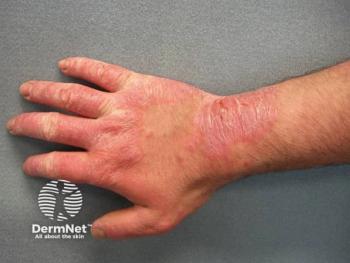
Unraveling Complex Dermatology, Challenging Diagnoses, and the Power of Visuals
Key Takeaways
- Thorough evaluation of pruritus is crucial to avoid missing underlying malignancies, as demonstrated by cases of misdiagnosed shingles and bullous pemphigoid.
- Recognizing severe forms of neutrophilic dermatoses, like necrotizing neutrophilic dermatosis, is vital for timely intervention, while avoiding overdiagnosis is equally important.
Lauren Madigan, MD, shares vital insights on complex dermatology, emphasizing accurate diagnoses and the importance of diversity in dermatologic imagery.
At the recent
In her session “Complex Medical Dermatology: Top Diagnoses You Can’t Afford to Miss,” which she presented alongside
“If it doesn't make sense, don't hesitate to go back and rethink and re-question and re-evaluate the patients. Make sure you get them the right diagnosis,” she advised.
From her presentation “Interesting Cases from Inpatient Consults,” Madigan highlighted the diagnostic challenges of neutrophilic dermatoses.2 She discussed the importance of recognizing severe forms, such as necrotizing neutrophilic dermatosis, which require urgent intervention. She also presented a case of VEXAS syndrome, an emerging diagnosis driven by clonal mutations causing neutrophilic skin inflammation. Equally vital was her caution against overdiagnosis, using a case of sporotrichosis misidentified as pyoderma gangrenosum to illustrate the value of biopsy and culture in preventing mismanagement.
“Underdiagnosis can lead to morbidity but so can overdiagnosis,” Madigan told attendees, “[We’re] wanting to make sure that we're recognizing these patients in the best way we can.”
In the “Kodachrome Case Studies” session, Madigan drew from her editorial experience with the Journal of the American Medical Association’s Images in Dermatology section.3 She reinforced the diagnostic power of morphology in classic presentations, while also warning about visual disease mimics. Additionally, she underscored the importance of diversity and representation in dermatologic imagery across skin tones and in emerging or rare diseases, citing Mpox as a prime example where widely shared images improved diagnostic accuracy.
Beyond the conference, Madigan is engaged in collaborative inpatient dermatology research, particularly around drug eruptions and complex infections. She also studies adult cutaneous mastocytosis, aiming to refine staging and treatment with targeted therapies like KIT D816V inhibitors to improve outcomes and quality of life for patients.
“I'm always excited to be participating in those types of trials or those types of investigations for our patients with complex drug eruptions or complex infections or just demonstrating the value of what we add to the hospital,” Madigan told Dermatology Times.
References
1. Madigan L, Patel A. Complex Medical Dermatology: Top Diagnoses You Can’t Afford to Miss. Presented at: 2025 Elevate-Derm Summer Conference; July 24-28; Park City, UT.
2. Madigan, L. Interesting Cases from Inpatient Consults. Presented at: 2025 Elevate-Derm Summer Conference; July 24-28; Park City, UT.
3. Madigan, L. Kodachrome Case Studies. Presented at: 2025 Elevate-Derm Summer Conference; July 24-28; Park City, UT.
Newsletter
Like what you’re reading? Subscribe to Dermatology Times for weekly updates on therapies, innovations, and real-world practice tips.



















